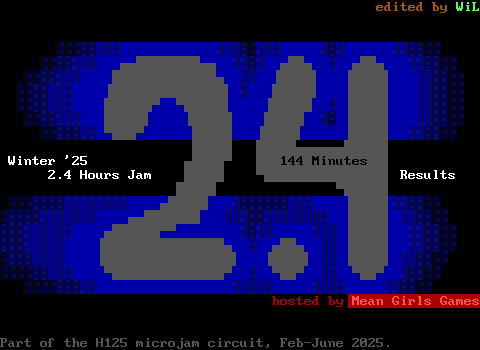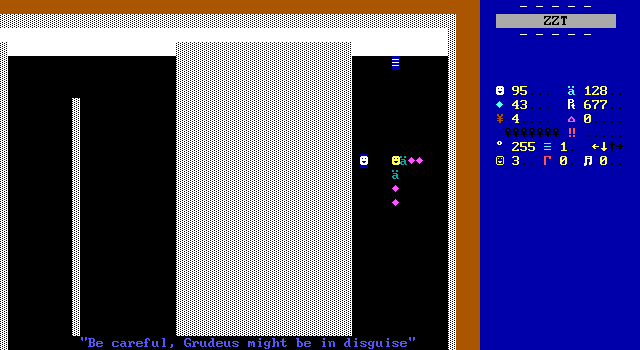1994 Puzzle Champion
Coming into Zandia, seeing those first few boards, I wasn't expecting all that much in the way of puzzles, even if the first thing I had to do was find a way to defeat an enemy without having any ammo of my own. The design read as being much more action-oriented, something to be expected from a younger author.
Action has always been easier to pull off in ZZT than puzzles. While ZZT provides numerous elements for both, creating a puzzle using nothing but standard elements mostly boils down to two basic puzzle designs. You either make a slider puzzle, or a maze. Probably with invisible walls. Slider puzzles are tough to get right, as even the slightest detail overlooked may result in players finding a move the author didn't that trivializes the entire affair. Meanwhile, if you go overboard in the opposite direction they go from fun, to intimidating, and eventually to "No thanks. I'm good". [2]
My feelings on mazes are well documented in dozens of Wildcard Streams. They're rarely more than a way to waste the player's time with nothing about the state of the game changing whether it takes 10 seconds or 10 minutes to navigate.
While I'm not surprised that LaMar did dabble in including some puzzles, something that still felt almost required for a proper ZZT game back then, I was surprised at just how clever some of them were. While the first few boards suggest a programmer that recently grasped the basics of ZZT-OOP, the reality is that the puzzles are just as important to the flow of Zandia as the action.
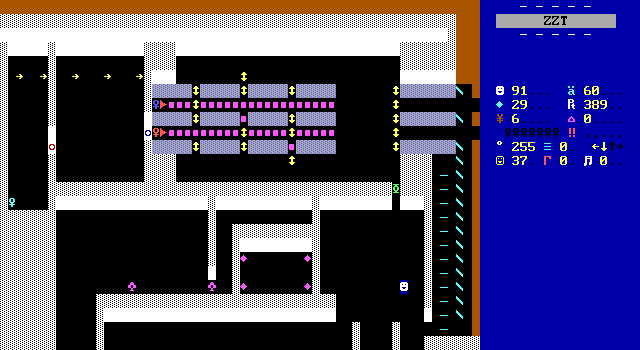
Sure enough, once inside the castle proper the first puzzle players encounter is a slider puzzle that look to be about as basic as it gets. Three columns can be shifted vertically to allow some pushers to move and provide access to the keys to the back of the board. Players need to figure out which of the two can be opened up while still allowing the pieces to be moved afterwards. The player will need to stop and think for a minute, and then they'll understand exactly what needs to be done and act on it.
It's very much what I was expecting any puzzles in Zandia to be.
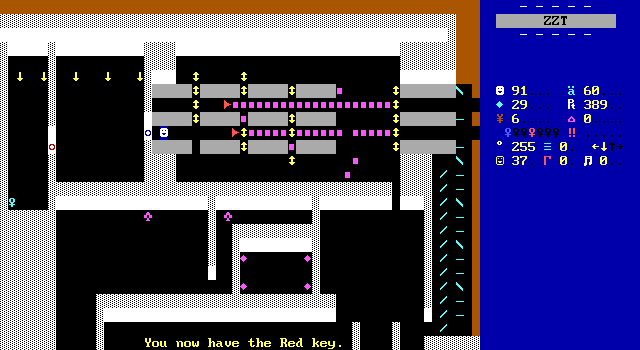
Even to the point where I did something I didn't feel like was intended, leaving the rightmost column of sliders in its initial position. You don't even have to take advantage of the conveyors to clear out the boulders. There's plenty of room to work.
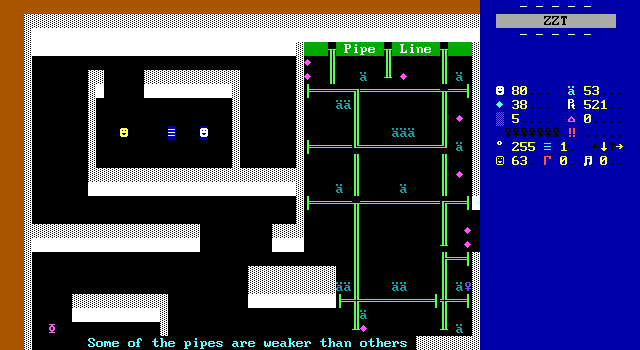
But it was the next puzzle, "Pipe Line", that won me over. It too is an incredibly simple puzzle that's nearly impossible to fail. However, it's definitely a creative idea. In particular, it's one that rewards players for knowing the rules of ZZT itself. Some of the pipe segments are objects that can be shot to destroy them. The rest are just green line walls.
Line walls always connect cleanly with any connecting line walls while objects can be any character desired. Players need to carefully study how the pipes are arranged and determine if a pipe's shape can only be made with objects. Shooting an object will destroy that pipe segment, causing a blue slime to spawn in and the room to begin to flood. The goal is to shoot your way through the pipes that can be destroyed, and hopefully be quick to minimize flooding as the slimes do spread at maximum speed.
The only thing really at stake here is your ammo. Misidentifying which pipe is which type means nothing more than wasting a bullet. Although those bullets are much better spent dealing with the flooding instead.
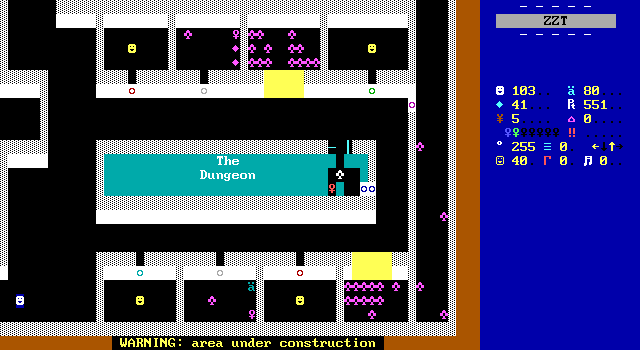
As with so many ZZTer's first (or near-first) release, the influence of Town of ZZT can be picked out from a mile away. Plenty of worlds really stick to the conventions established in Town in particular thanks to its shareware status making it the likely first ZZT game played for a huge number of players. Often as ZZTers found themselves more comfortable creating ZZT worlds, and coming across non-Sweeney created titles, the non-linear key-collectathon structure goes away in favor of making worlds to set a game in rather than trying to wrap up gameplay elements in a connected world.
Even a game as basic in premise and chock full of early ZZT world gameplay, it's enough to make this feel like a cute little callback, taking something from Town and modernizing it just a bit.
LaMar takes the iconic "Guardian of the Key" puzzle seen in Town and tweaks it to fit in with Zandia. Instead of a silly guardian pacing endlessly until the doorbell is rung, this one is busy napping. The only way to get the red key being to find a way to get the guard out while also unlocking both doors to their little room.
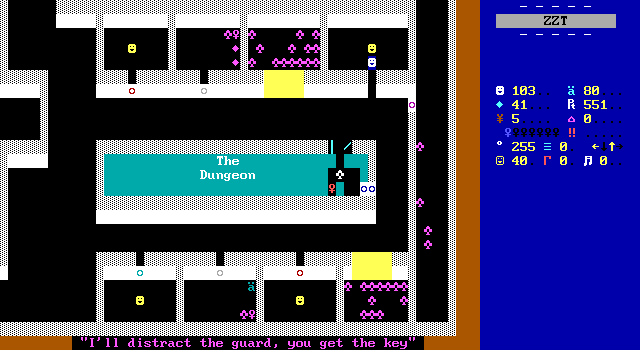
As in all good ZZT games, prisoners are meant to be freed. This one provides the method to get the guard moving by creating a distraction, allowing players to slip in through the two blue doors (assuming they have the keys), grab the red key, and slip back out before anything amiss is noticed.
First off, this is really funny. The prisoner, whose cell is now wide open, is happy to insult the guard a bit to get them to step outside for a moment, unsure who just said those awful words. Like ringing the doorbell, there's no limit as to how many times you can try this ruse. Be quick and the red key is yours.
When done correctly, it's no different than what was seen before in Town. LaMar adds his own twist to the puzzle by adding a point of failure to it: Once the guard is in the halls, they'll check if they're aligned with the player. If they are, the player is caught in the act and the two cells filled with ruffians open up, transforming the puzzle into another action scene. (Additionally, the guard themselves transforms into a standard ruffian.)
It's hardly a difficult puzzle regardless of one's (lack of) experience with Town. I can't help but appreciate how LaMar found a way to add a failure state to the design, and how that failure just changes what needs to be done to get the key rather than causing the game to come to a halt that requires a reload.
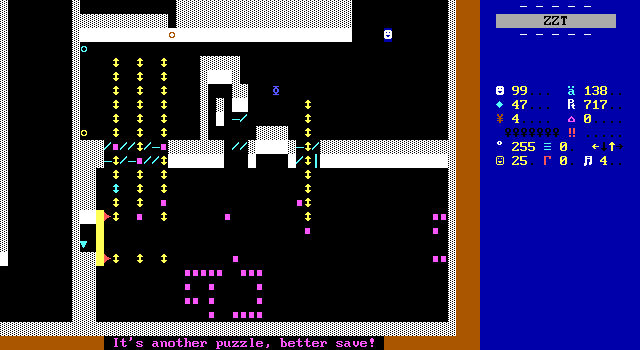
Deeper within the castle is another puzzle focused on pushers and sliders. This time LaMar really demonstrates what he can do by making something both unique and challenging. The goal of this puzzle is to find a way to shoot the cyan robot (the downward facing triangle in the screenshot). The robot moves automatically, rotating counter-clockwise whenever it's blocked in the direction it's currently facing. This time the goal is to use the sliders to create obstacles that will guide the robot up out of the player-inaccessible part of the board to somewhere it can be shot.
To do this, there are four columns of sliders, a button to free the robot from its initial captivity, and a button to turn the lone cyan slider into a boulder. As with the previous slider puzzle, the number of possible moves are rather limited. Even more-so this time as each column can only be pushed downward. The challenge isn't one of figuring out the arrangement of columns, but rather to understand when to push them.
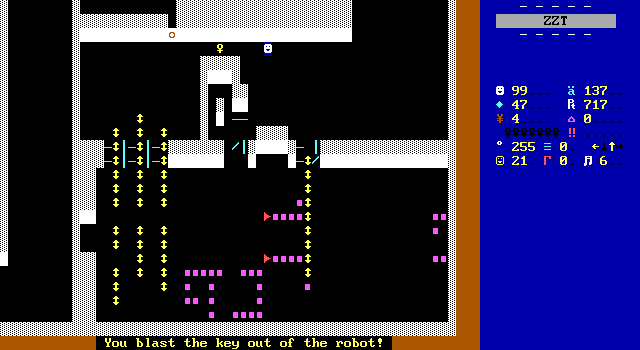
The experience lasts a lot longer than the previous puzzles. This one did take me a few attempts to piece together what needed to be where, and when. LaMar helps expedite the process with the arrangement of boulders that can't be manipulated in any way. These boulders take common failure points and cause the robot to get stuck in a short infinite loop to make it obvious when at attempt has become unsalvageable rather than lead players on with the robot bouncing around all over the place. It draws a clear line between success and failure, keeping players from overthinking the puzzle to require some lengthy journey for the robot. No need to hold your breath with these boulders. They'll let you know right away that your proposed solution is being dashed on the rocks.
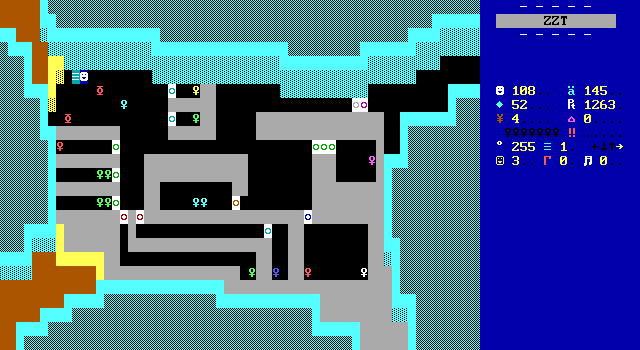
While not the first thing I think of when I think of ZZT puzzles, perhaps I shouldn't have neglected to consider the key puzzle to be a classic code-free puzzle design. You could argue that as with mazes there's nothing being done here other than delaying players, but I refuse to accept my hypocrisy and will instead bring up that you can at least screw up these puzzles and have to revert to an earlier save.
I really like them! I liked them in Caves where only one color key was used. I liked them in Winter where the keys could only be collected from the innermost to outermost in each section. I liked them in Ana where a series of them culminates in boards almost exclusively built out of keys and doors.
The only real complaint is that it's so difficult to tell what color doors are here, though that's one where you can blame Sweeney rather than LaMar. STK graphics hadn't even been available for an entire year when this game was dated. Although non-STK solutions to the issue were always available. Coloring the adjacent tiles to the door to match the color key needed would go a long way in making this board so much easier to comprehend. No STK needed.
Granted, even in the time when STK use was expected or even mandatory, the ZZT community was filled with members still in their teens and early 20s unaware that their impeccable eyesight might not last. The practice of making sure door colors are obvious was hardly common practice until the modern era when all of us elderly veterans began to beg everyone to not use the default doors.
Honestly, exchanging the colors of some of the more common keys would have been been a welcome help. Green and cyan are the most commonly used colors here and are perhaps the worst color pair to differentiate (for me at least). Not that red and yellow are that far behind. Purple is also a bit of a pain with those two. ZZT's doors are really awful!!!
A-hem.
Right. So. The puzzle. It's good. Made slightly more annoying due to the walls being made out of water causing some unpleasant noises anytime you accidentally bump into anything. It is ultimately a time waster, sure, but it's wasted time that's enjoyed picking the locks, planning ahead, and second guessing yourself as to whether or not five moves from now you'll have used all the green keys or not.
Beyond that point, Zandia really cools off with the puzzles, not having anything else up until the final chapter of the game where what awaits players is nothing satisfying. Two of the game's last five boards include some really basic stuff, that I'd have hesitated to dwell on if not for the strong showing the puzzle design had prior to this point.
Almost certainly it's just your typical case of ZZT-fatigue where authors frequently don't know when a game needs to end, and suffer from the idea that more boards is a universal positive. You see this last chapter slump in quite a number of releases, and it's especially prevalent in worlds which were already large, in particular ones like Sivion where the sheer size of the game is part of the game's promotional material.
Zandia's puzzles aren't the only thing to suffer here. The last few boards, puzzle or otherwise are mostly empty hallways that no longer have the appeal of hinting at something else to uncover later from another angle.
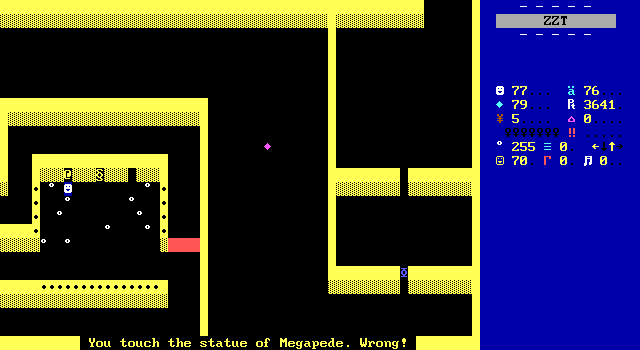
The final area of the game is a temple filled with traps. Except there aren't all that many traps and there's nothing else to discover that isn't a trap. A series of statues and a locked gate requires players to touch them in the correct order. The statues are depictions of the game's three boss characters and the solution is to touch them in the order they were faced.
It's not much of a brain-teaser. I suppose the invisible statue of the invisible boss might count for something, although there's a gap in the wall where that statue makes itself obvious by virtue of there not being a wall tile.
Really the only difficulty is that the boss characters likely aren't going to be remembered with player just seeing some objects to investigate, only putting together what they're actually looking at when they touch the first statue and are attacked with a volley of bullets from the walls when the wrong statue is touched. The moment you touch the first incorrect statue, it's clear what you're actually meant to do.
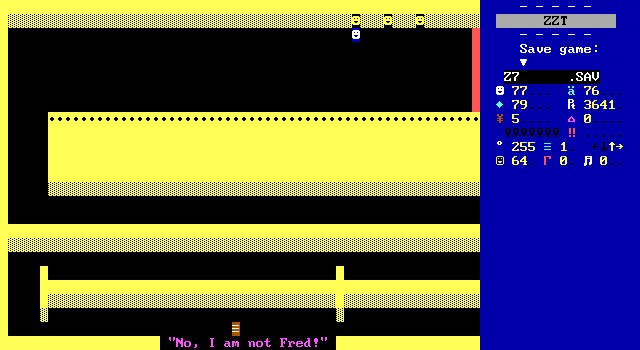
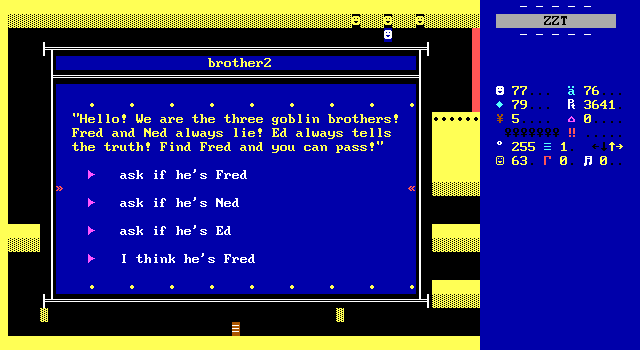
The final puzzle is a very slight spin on the "one tells the truth, one tells lies" seen in, well, everything by now. To LaMar's credit, he expands the idea out a bit into three "goblin brothers" with two liars and a truth teller. With how common the two-man variety is, I did at least have to stop and make sure to not second guess myself. It beats the original puzzle design, but doesn't really become more rewarding to solve.
I was however amused by the fact that all three of them do truthfully explain the rules, only slipping into their lies when asked about their names. Now, finding a way to work how each one explains the rules into the riddle and you might have something.
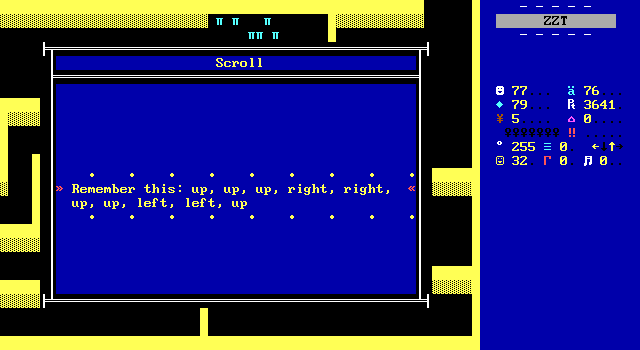

Alright, there's one more puzzle actually. A maze with trapped walls that hurt players when touched (-5). The solution is presented immediately before you reach the maze, making it an immediate test of memorization, which I immediately screwed up as I was unsure if that directions from the scroll meant from the player's position or from the scroll's position. Whoops.
Well, they can't all be winners.
Despite the more dull designs of the temple, Zandia left me feeling overall rather impressed with what it managed to accomplish with its many puzzles. There was a rather nice mix of classics, classics with a new twist, and one really memorable design in the Pipe Line board. For the earliest known release by LaMar, this is a strong start. Most games of this style made by younger authors rarely do much with their puzzles, which rarely feel like they do anything other than get players to stop shooting for a few seconds before they zip right through them effortlessly. Unless they go for easy to design, yet miserable to play mazes. Zandia's worst is commendably mediocre given the dire designs seen in countless other worlds. At its peak, the game showed a lot of promise in original puzzle design. Fun to solve, not too frustrating, and spaced out generously enough that they were approached with an optimistic curiosity towards figuring out your next move.
The Dastardly Villains
Regardless of the extremely light presence of a story to Zandia, there are still a number of named villains players need to face off against in their chase to stop the evil king of Zandia. The castle, underground, jungle, and temple areas all culminate with boss fights, cleanly dividing the player's progress on their adventure. It's very much the kind of cast you'd expect from a younger author, which makes for some goofy opponents.
Grudeus
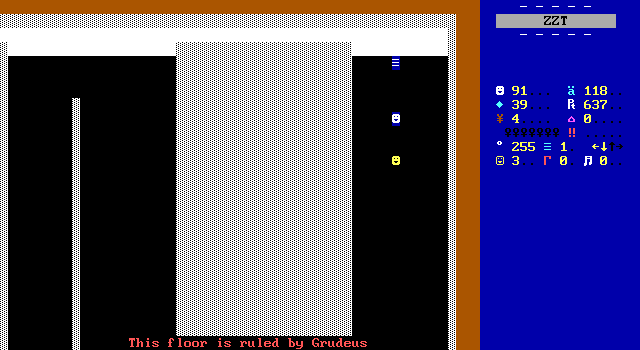
The first character to be named is "Grudeus", and due to the lack of story development I really can't comment on what Grudeus's whole deal is. He can disguise himself. That's it.
What connection he has to the king is inconsequential. He is simply here to serve as the opponent in the game's first boss fight. With nothing to really go by beyond the name, I have to say, I love Grudeus. Have you tried saying Grudeus out loud yet? You really should.
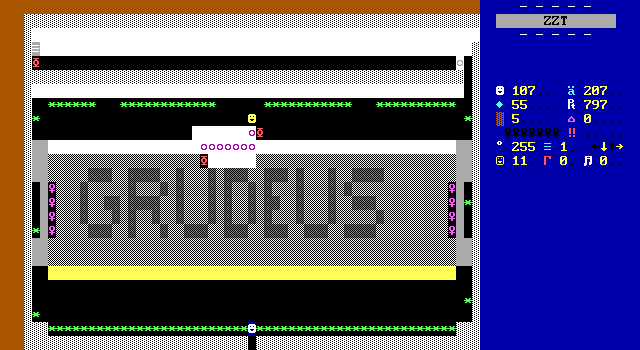
As a character, Grudeus is very incomplete. I at least assumed that somewhere on this floor of the castle there would be some ally that would turn out to be Grudeus in disguise, ambushing the player or leading them into a trap. Instead just outside his arena is a scroll which tells you to save before the fight. Then you see Grudeus in his room with GRUDEUS written in breakable walls. He's not nearly as sneaky as I thought.
The hint at Grudeus being in disguise was at least relevant, though his true form is revealed at the start of the fight which sells the concept short. Plus the obligatory mid-90s "NOT!" line.
The battle is at least a unique idea! LaMar at this point struggles a bit at hooking players with a good story, but he's found plenty of opportunities to surprise players with the unexpected.
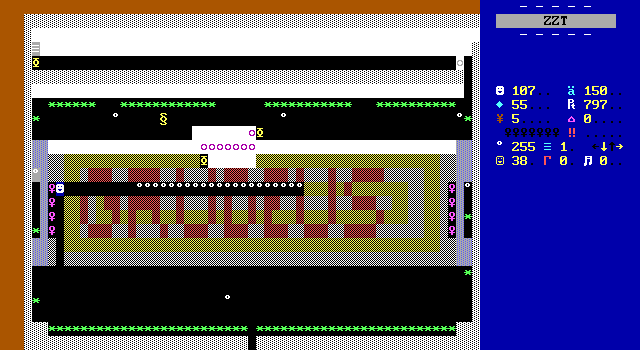
Grudeus can't be harmed until the player can actually get close to him. The first thing the player needs to do is unlock a considerable number of purple doors that divide the upper part of the arena from the rest. While tunneling, Grudeus shoots bullets to the sides that hit objects that merely look like ricochets which in turn shoot bullets south. The lack of actual ricochets keeps players from being able to strike back using the same mechanism in reverse.
The middle and lower ri-faux-chets™™™ pace up and down repeatedly, and fire towards the player when shot. The idea is that while you're trying to turn in your purple key (of which only one can be carried at a time) that the objects will end up shooting bullets in your direction. With each key collected, there's more room for them to fire shots that can potentially strike crossing players.
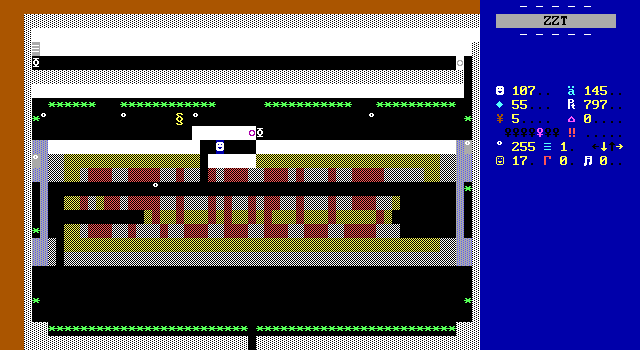
It's a good attempt at making an original boss design, though it doesn't work well at all. The keys themselves can be used as shields so it's easy to stick to the top row for horizontal movement and only dip lower when you need to grab a key. By the time I collected the last key, only the row that I tunneled out was actually dangerous to cross.
Even had I been more haphazard in my excavation, due to the random positions of the objects when they get to shoot the odds remain stacked in the player's favor. Most bullets shot inward won't even have the potential to hit the player. Worse, the objects specifically use #shoot seek, which means if the player isn't aligned to begin with there's only a 50% chance that the bullet will be fired into the area in the first place.
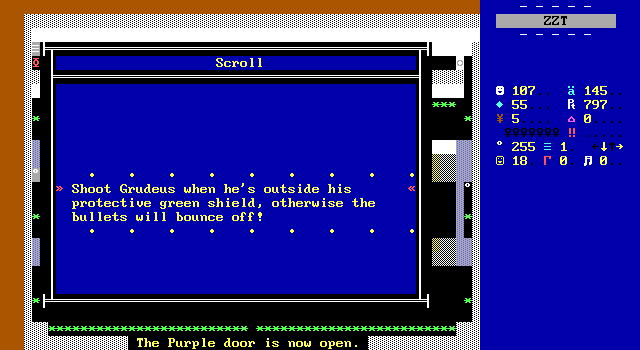
Getting to Grudeus is just the first step though! Afterwards players need to start shooting him directly. Again LaMar does something I hadn't seen before. Grudeus continues doing what he does best (moving left and right and shooting towards the player), however the limited space up here requires players to take a unique approach to shooting him.
Objects can't be shot at point blank so going above or below for free shots won't work. Shooting from the side is made more complicated thanks to the green shield. When Grudeus stands below one of these actual ricochets, bullets that are about to strike him realize they're about to hit an obstacle, and instead use the ricochet to deflect themselves. I don't think I've ever seen the higher priority of ricochets over objects turned into a mechanic like this before!
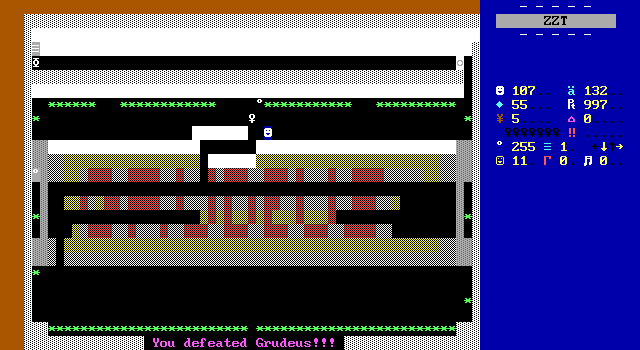
Again, it's a cool idea that's more exciting to imagine than to play out. You just kind of need to wait for Grudeus to move somewhere his ricochets aren't before firing, and can do so from the bottom row where none of his bullets can hit you.
While it's got plenty of issues, the uniqueness won out in the end. Once again the novelty of something different but flawed wins out of the tried-and-true kind of fights that I've seen hundreds of times before. As long as it skews too easy rather than too hard, there's no question that this provides Zandia with something to boast about that other worlds can't.
Megapede
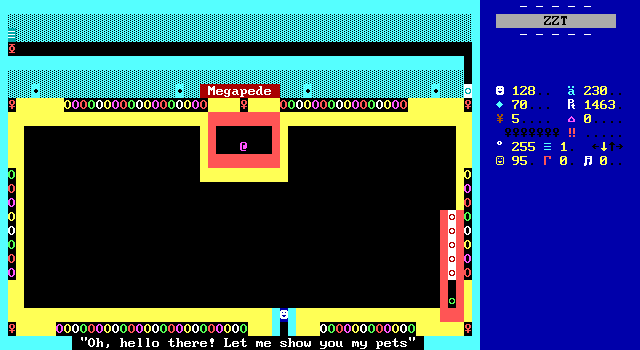
The second boss lies at the end of the underground tunnels that run beneath the castle. Megapede here gets a similar lack of buildup. A scroll a little way into the underground announces them as the ruler of the underground in a mere four words. Just before entering their arena a friendly NPC suggests buying some ammo from them before the fight.
This second fight isn't quite as original, though it still avoids the usual chasing down an object that moves and shoots constantly. Like with Grudeus, the player needs to pick up a bunch of keys in order to be able to actually reach their foe. This time the obstacle is the huge number of centipedes that are let loose at the start of the fight. More specifically, they're all segments which can't find a head to attach to and so they all turn into heads with no segments creating a very chaotic scene[3]!
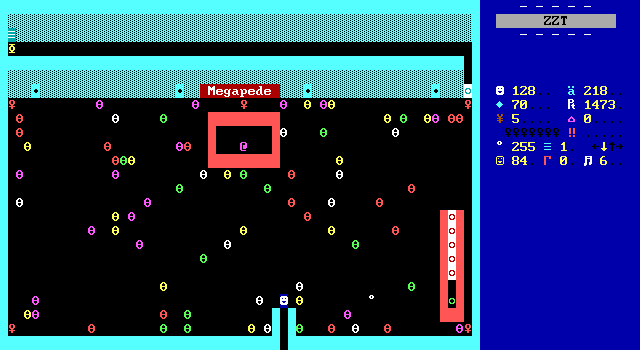
Centipedes in this form are an underrated enemy in my opinion due to how good they are at dodging shots. While other ZZT creatures merely focus on whether or not to move towards the player, centipede heads will try to turn when they bump a wall. This is meant to allow fixed rings of centipedes that hug the walls of their enclosure. It has the helpful side effect that when a centipede wants to move, but they're blocked by a bullet that's about to hit them they simply move out of the way. If there's a body attached then that will end up being struck, but for individual heads, a lot of well-aimed shots end up missing instead.
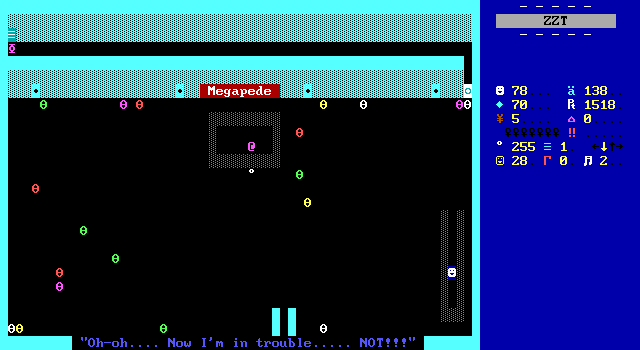
Once all the doors have been unlocked, touching the button changes the walls to water so that Megapede can be dealt with directly. The use of water is unexpected as it means Megapede is confined to a very small space. From their little cell they begin to move around in a fixed left/right pattern while taking shots at the player. The limited movement allows players to either pick a spot and wait, or to go from the sides and fire some extra bullets to deal with Megapede's.
All the while any centipedes that haven't been defeated will still be running around so it's easy to get careless and not notice one until they attack. Each successful shot on Megapede will also make the holes in the walls up top produce a new centipede head, which is easy to not even notice if you haven't really thinned out the numbers before pressing the button.
The end of the fight isn't too exciting due to the restricted movement. I think actually freeing Megapede might have worked out better as the leftover centipedes do a good job of making sure players still have to tread carefully even with the boss confined to a limited area. I feel like expanding the shootout to the entire board would have made for a good challenge. Although, then there's the possibility that players would opt to shoot every last centipede before freeing Megapede which doesn't sound particularly fun.
The Invisible Guardian
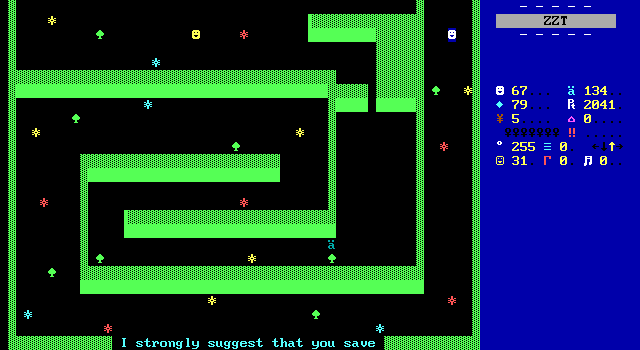
The third guardian gets even less buildup. The jungle that surrounds the game's final location of a temple doesn't have much opportunity to introduce anything new to players. The boss gets no prior mention until they show up, err, well, that's not really the right word.
In addition to the message about saving, players that look closely can notice a few half-block characters against certain walls, and a small region of the board devoid of vegetation. This is the next arena.
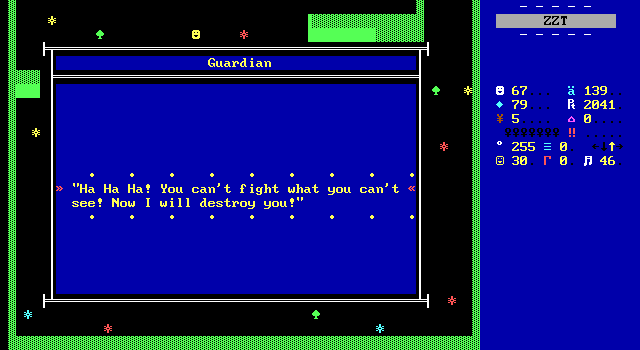
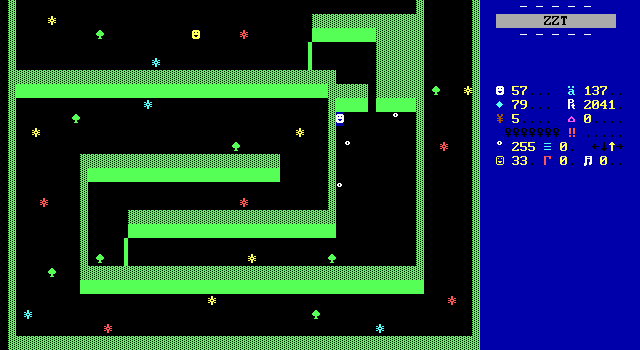
Fittingly, the third boss is indeed invisible. This is the one boss that does utilize the traditional design of run and gun, forcing players to rely on bullet-sonar, either by observing where the enemy shots are coming from, or by sweeping the arena themselves shooting after every step to play the odds.
I've never been a fan of these fights as the slow movement of ZZT's bullets compared to most games means that you have to lead your shots against an invisible target. The Guardian does move in a fixed rectangular pattern which means it is possible to anticipate their moves. Doing so requires being patient as the pattern will be interrupted if you do land a shot.
Watching and waiting rarely works out in players' favor with ZZT, and the sonar-strat is likely what players will immediately opt to do knowing full well that even the slightest bit of randomness in the Guardian's movement will throw the possibility of landing a skilled shot out the window. A near-miss may cause the Guardian to bump against a bullet as an obstacle, also breaking the pattern and requiring players to recalibrate themselves.
While not as bad as other invisible foes in other games, the Guardian is by far the game's worst boss. The rest all go for something a little different. This is just your basic baddie who happens to be invisible to slow players down. If you're quick, you should be able to stun-lock them after landing a hit at least as the object doesn't lock during the brief moment of visibility afterwards to let players know they struck their target.
The Evil King
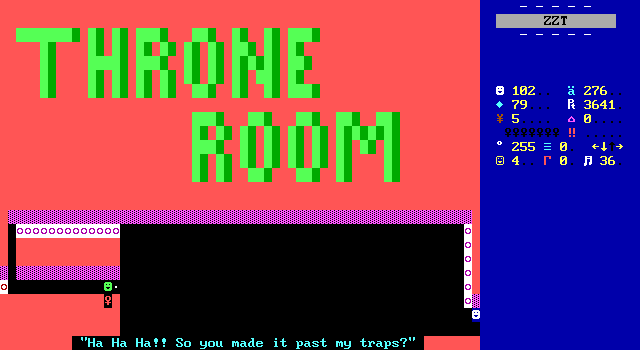
For the final showdown with the evil king, LaMar gets inspired once again, resulting in one of the strangest final boss fights I've come across. The king is pretty straightforward. He moves endlessly towards the player, shooting towards them as they go. This would usually make for a pretty boring fight where as long as players can keep their distance, they can shoot without worry of reprisal. Shoot the king five times and he's defeated.
If that was all that the fight was, it would be a lackluster way for the game to end. Instead, LaMar creates this setup where the king is locked away in a safe room and a duplicator produces copies for the player to deal with instead!
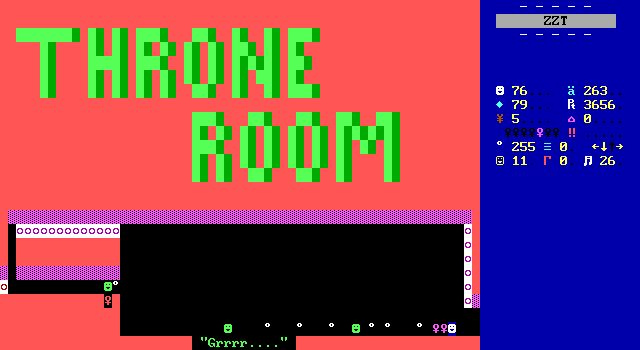
Each defeated king drops a purple key to unlock the safe room and deal with the original. The challenge then is to not get overwhelmed by clones as well as dropped purple keys! Once they player is carrying a key the others are essentially walls that the enemies can push. It's possible to get trapped against a wall if you're not careful here. LaMar seems to have realized this. At least, I assume that's why there are some extra doors on the eastern wall to help players get rid of extra keys.
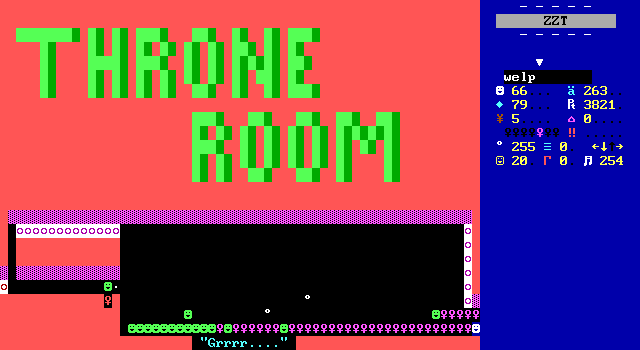
The actual duplication rate isn't that high, I just wanted to see if I could max out the game speed and cheese the fight.
The kings will of course shoot each other on the player's behalf making the five hits required go by in no time. Given the health I still had by the time I reached this fight I think it's a good concept that could have done with just a bit more polishing.
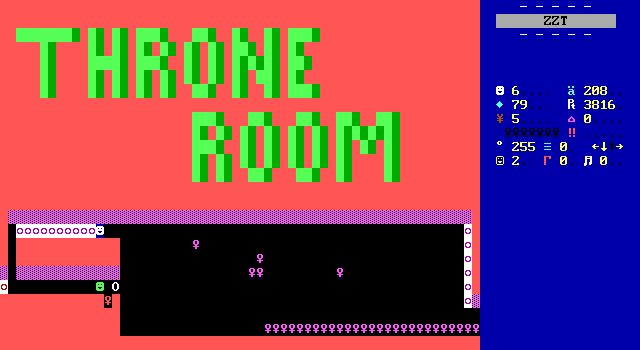
In particular, there is a quirk here where the original king is also trying to move towards the player at all times. Normally this keeps them up against the duplicator, but after unlocking a few doors you can begin to lure the king away from the duplicator before the next duplication. This makes the fight drag on a bit as you'll find yourself stopping after each key and dealing with only one or two king clones afterwards.

Since every king object is identical, it also means that nothing special happens after defeating the final king. Setting a flag once the player passes through the last mandatory purple door and changing the output message for the final, original king would have been nice, but then this game hasn't done much with a story before so why should it now?
Even with their many oddities, the bosses of Zandia were a good addition in the end. LaMar is pushing against his limits here, seeing what he can pull off. Looking at these designs it's no wonder where some of the impressive battles in Ned the Knight came from. Every one of them, even the admittedly "been there, done that" invisible Guardian had an undeniable charm to their encounters.
Final Thoughts
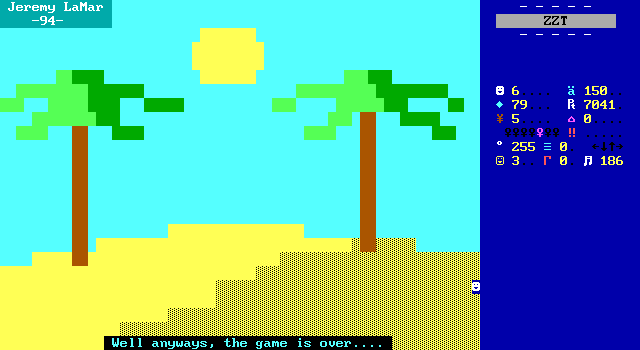
Simply put, Castle of Zandia was a fun way to spend an hour or so. For the fans of Ned the Knight, this isn't yet the LaMar you know and love. Here he's a promising upstart new to the worlds of ZZT. The adventure contained within won't blow you away with its visuals, or gameplay, but you can expect to enjoy yourself the entire way through. LaMar created a very gentle game with plenty of heart here that really exemplifies what younger authors could accomplish through ZZT. It's simple design, clear goals, and variety make it a worthy addition to the collection of Beginner Friendly Worlds.
The puzzle are of a surprisingly high quality. What most would expect to be the worst part of Zandia ended up being its most memorable. The second slider puzzle is another great example of putting a twist on a well-established concept, helping the game to proclaim its own identity in the classic ZZT adventure genre. The puzzles are fairly easy to solve as well, maintaining the breezy feeling of the game's action sequences as well. It all combines to make for an enjoyable experience with no real annoyances.
Boss fights are elaborate and try to buck the established conventions of two smiley faces running around in circles throwing smaller circles at one another. This is probably the best hint in the game of what was to come later with Ned. While none of the bosses work as well as LaMar would have hoped, it's hard to not appreciate him for trying something different. In the case of Grudeus, the use of ricochets to prevent an object from being shot is something that I haven't seen prior to this game, and is definitely a trick to keep in one's pocket.
The friendly NPCs you meet also contribute significantly to the light-hearted tone of the game. Many ZZT games are designed around the player character being the only one attempting to do anything to stop the villains. Here it seems like everyone is in this mess together, and while the player is ultimately the one responsible for saving Zandia, their help turns it into a team effort.
Really, the only complaint I have is the story just isn't there. Normally, it wouldn't be an issue, but because of the number of friendly faces, and the boss characters that feel like they would be fun adversaries to run into elsewhere it's a missed opportunity. Grudeus should be taunting the player at every step of the game. The evil king should be leaving notes for the player as soon as they step inside the castle. These characters are the type that should be easy to build excitement for the inevitable showdowns. Instead they just show up when they need to be fought where they all happen to be men/creatures of few words.
If this game was a cake, it could be made even better with some extra icing on top. As it is, you should still definitely think twice before you turn down a slice. Castle of Zandia is a welcome sight for those with fond memories of downloading ZZT worlds based on title alone and hoping for something memorable. For a first step into ZZTing, Zandia offers a lot of quality that shouldn't be taken for granted. This is the kind of world that a ten-year old would be inspired by, and a relaxing nostalgia trip for those whose days of random ZZT downloads have long passed.

